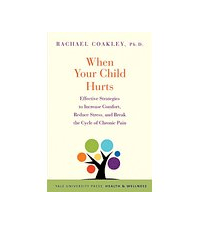“When Your Child Hurts: Effective Strategies to Increase Comfort, Reduce Stress, and Break the Cycle of Pain”

“When Your Child Hurts: Effective Strategies to Increase Comfort, Reduce Stress, and Break the Cycle of Pain”
By Rachael Coakley, Ph.D.
Yale University Press
New Haven, CT, 2016
Book offers valuable information on pain management
Reviewed by Kerry Morrison, Psy.D.
This new publication by Rachael Coakley is a gem of a book filled with easy to understand concepts, coping strategies for parents and children and creative yet useful techniques for managing pain, coping with pain-related challenges and building resilience in children with pain.
This impressive, user friendly volume was a delight to read and offered critical information for both parents and practitioners alike. The author offers salient clinical examples from her practice as a pediatric psychologist at Pain Treatment Services at Boston Children’s Hospital.
Coakley states that 25 percent of children will develop chronic or persistent pain. Chronic pediatric pain can be a very challenging condition to treat. In fact, she cites one research study that found that pediatricians could not agree on the cause of chronic pain in 60 percent of patients.
For another third of these child patients, pediatricians could not agree how to treat them. The author states that chronic or persistent pain is a complicated problem. In her practice with children and families, she said that her job is not to evaluate whether the child’s pain is real. She knows that it’s real and that the patient is hurting. Her job is to understand how pain interferes with the patient’s life.
The book is ordered in logical chapters. Coakley provides easily accessible explanations of pain, namely how the human body senses, interprets and responds to pain.
She also discusses the link between stress and pain. Managing pain by developing resilience and self-efficacy is emphasized. Included are many innovative techniques for fostering self-efficacy.
Coakley also offers many gold standard behavioral medicine strategies for managing pain. Traditional behavioral medicine strategies addressed are Cognitive Behavioral Therapy, mindfulness, self-hypnosis, physical therapy and occupational therapy as well as alternative therapies such as acupuncture, nutrition, yoga, aromatherapy, Reiki, massage and cranial-sacral therapy.
The author writes a detailed chapter on diaphragmatic breathing and scripts (guided meditation for all ages) for pain reduction, including Progressive Muscle Relaxation.
The final chapters look at the issue of school because 50 percent of children with chronic pain have trouble keeping up with the demands of school and school work.
Sleep, friends and family also get chapters. Each chapter ends with “How to Help” sections that have well thought out and constructive suggestions.
The book closes with an up-to-date resource list of helpful Web sites, useful books and videos, innovative Apps for pain management and relaxation, and pain-management programs by state.
Many of the author’s ideas and resources are applicable to adults as well as children and some of her illustrations make for useful client handouts. I would not hesitate to recommend this valuable volume to both parents and colleagues. In fact, I will purchase this for my own library.
Kerry Morrison, Psy.D. is a licensed psychologist in private practice in Greenfield, Mass., who also consults, teaches and provides trainings on mental health topics.
Learn more about the book: When Your Child Hurts: Effective Strategies to Increase Comfort, Reduce Stress, and Break the Cycle of Chronic Pain (Yale University Press Health & Wellness)
